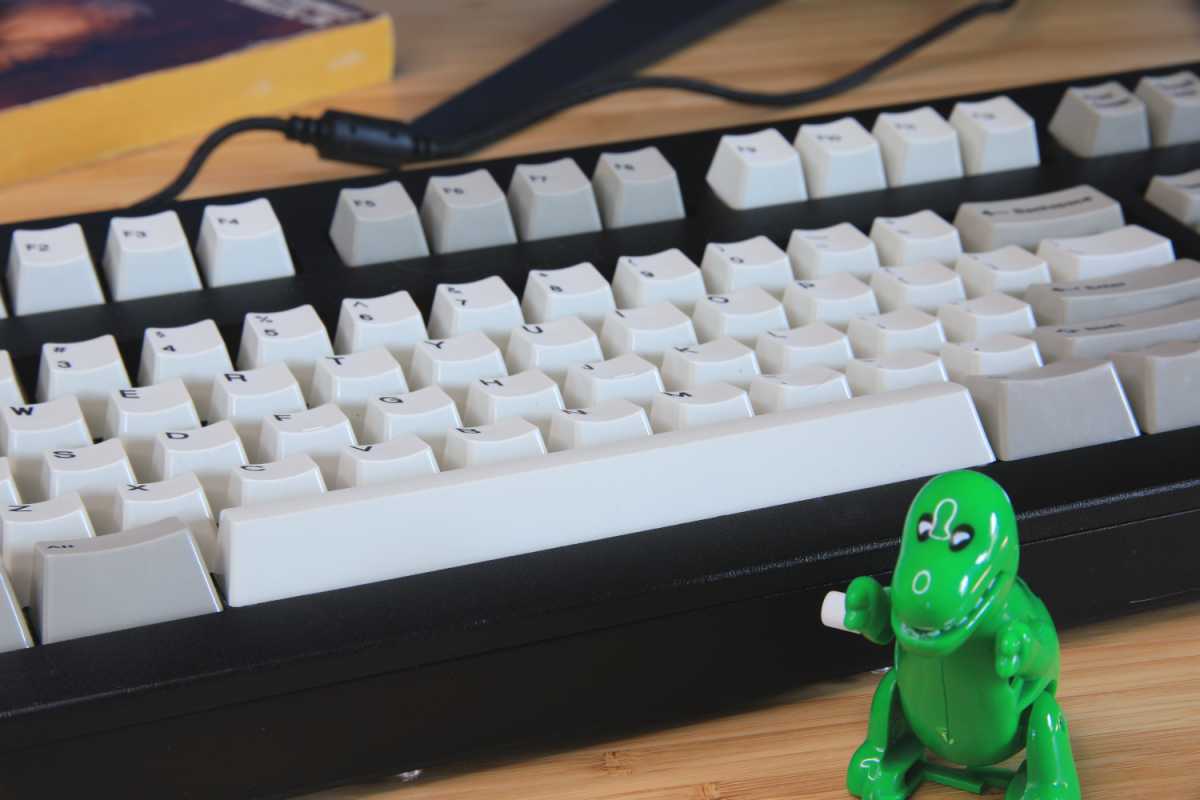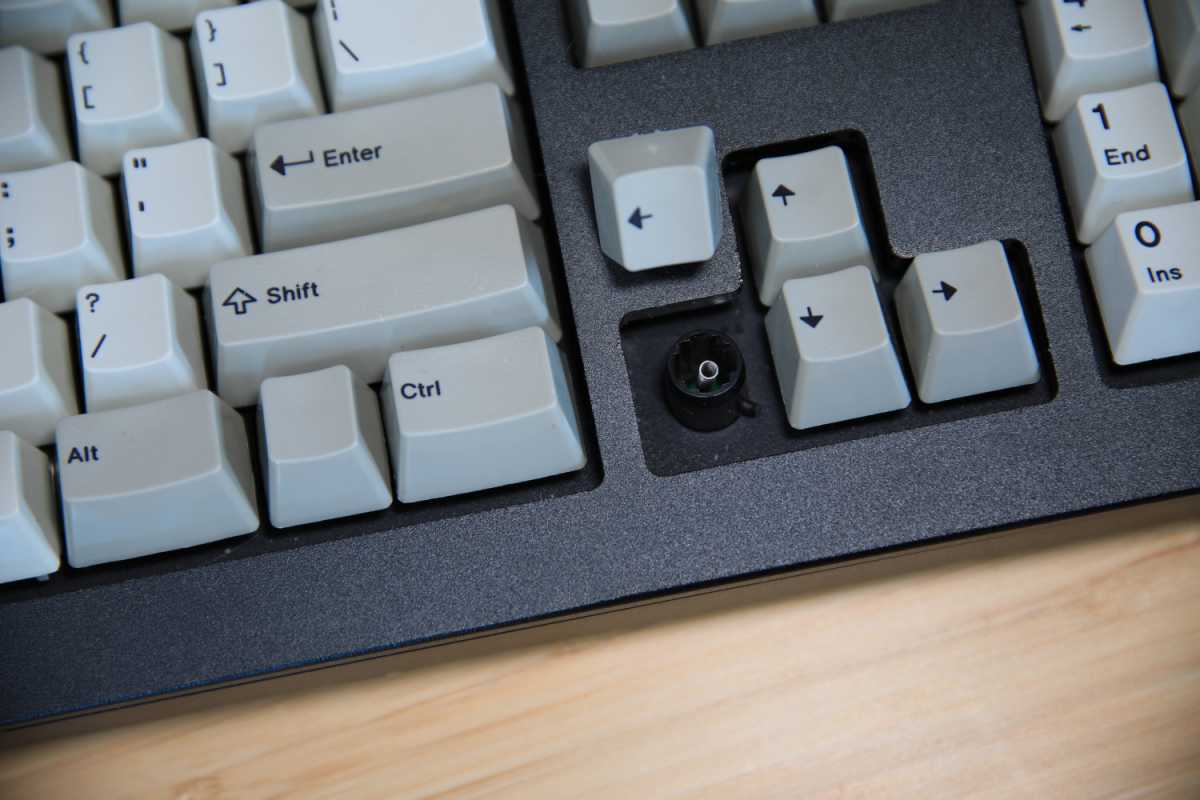Model F Ultra Compact keyboard review: It somehow improves on IBM’s classic
Expert’s Rating
Pros
- Excellent typing feel
- Classic layout is instantly familiar
- Durable die-cast metal chassis
- Easy to repair and customize
Cons
- Heavy key feel isn’t great for fast-paced games
- Lacks modern hardware and software features
- Expensive
Our Verdict
The Model F Ultra Compact is a hardcore buckling spring keyboard for nostalgic enthusiasts.
Price When Reviewed
$420
Best Prices Today: Model F Ultra Compact
Modern mechanical keyboards hold endless possibilities in design and function, yet one experience remains rare: the classic buckling spring keyboard. This key switch design was popularized by early IBM keyboards, such as the Model M and Model F, which are prized for their uniquely clicky tactile feel.
Enter Model F Labs, a small company set up exclusively to produce buckling spring keyboards. The model I received, the counter-intuitively titled Model F Ultra Compact, retails for an intimidating $420. That’s a high price to pay for a keyboard with few modern conveniences—but I’m sold.
Further reading: For more keyboard recommendations see our roundups of the best gaming keyboards and best wireless keyboards.
What’s a Model F keyboard, grandpa?
IBM’s Model F is the original buckling spring keyboard launched in 1981 alongside early IBM PCs. It was standard issue for most IBM PCs through 1985, when the Model F was replaced by the more famous and affordable Model M (the Model F was still produced until 1994, however).
The distinction between the Model F and Model M is important, at least to enthusiasts. Though both are buckling spring keyboards, Model F keyboards don’t have a membrane but instead rely on metal barrel plates. They’re also absolute units: Most Model F keyboards have odd layouts or extra function keys. That’s why the Model F Ultra Compact, which is based on the Model F 104, doesn’t seem to fit its name. It’s large by modern standards but small compared to many original Model F keyboards.
None of this matters if you’re not a Model F enthusiast, but if you are, I think you’ll still like what you see. The Model F Ultra Compact’s layout offers the feel of a Model F but is condensed into a more modern arrangement. However, it’s not a one-to-one reproduction of the original look, as this model lacks the swooping accent lines that border each side of the original Model F keyboard train.

You can see how solid and sturdy the Model F Ultra Compact’s construction is. It will last a lifetime!
Matt Smith/Foundry
The Model F Ultra Compact subverted my expectations with improvements to the durability of the original design. Original Model F keyboards sold for hundreds of dollars in the early 1980s (adjusted for inflation, some carried an MSRP above $1,000) and were robust, using thick plastic casing over a metal backplate. Yet the new Model F Ultra Compact has them beat with a die-cast aluminum case and backplate that weighs in at roughly nine pounds. IBM’s design was rugged, to be sure, but the plastic inevitably becomes brittle over time and is prone to discoloration, problems the new all-metal keyboard won’t have.
Enthusiasts looking for a more accurate reproduction should turn their gaze towards the Classic Style Model F or, if you want an even more obscure and classic layout, models like the F77 and F62. These more faithfully mimic the look and feel of original IBM keyboards.
The Model F can keep up when I blaze away at 100 words per minute but feels satisfying when I find myself slowly writing, deleting, and re-writing the same sentence a dozen times over.
What makes the Model F’s buckling springs so special?
The Model F Ultra Compact certainly looks like a retro keyboard, but that’s not its most important trait. This keyboard lives or dies on the quality of the buckling spring switches underneath each key. Fortunately, they’re excellent.
Buckling spring key switches do what they say on the tin. A spring is beneath each key, as true of most modern mechanical keyboard switches, but the spring isn’t placed on a stem but instead inside a barrel. The spring provides resistance when pressed but eventually buckles, providing firm tactile feedback with a distinctive click.
Whether this is better than modern tactile switches is a matter of opinion. Modern switches are more versatile, offering a variety of options for feedback, noise, and speed of actuation. When it comes to sheer typing enjoyment, however, the Model F’s buckling spring feels more lively than modern mechanical switches. The difference is both felt and heard, as this reproduction Model F clicky-clacks like a horse trotting down a brick road.
Personally, I love it. The Model F feels engaging, enjoyable, and accurate. It can keep up when I blaze away at 100 words per minute but feels satisfying when I find myself slowly writing, deleting, and re-writing the same sentence a dozen times over. It’s a typist’s key switch.

Replacing the keys and springs on the Model F Ultra Compact is easy, with Model F Labs offering all the replacement parts.
Matt Smith/Foundry
How is the Model F Ultra Compact for other tasks?
The Model F’s bucking spring feels less at home playing modern games, like Counter-Strike, or scrolling through a video timeline in Adobe Premiere. It requires a heavy force to activate and is relatively sluggish to return, so it’s not great in any situation where a user rapidly, repeatedly activates a single key or flips between a few keys quickly. It also lacks the macro buttons or dials that can be found on some modern keyboards, useful add-ons that are handy for many photo and video editors as well as digital artists. The keyboard doesn’t even have an LED backlight, so you’ll either need to remember the keyboard’s layout or keep a light on at night.
Personally, I would never use this keyboard for all tasks—it’s just not well suited to gaming. If I owned it, I’d pair it with a compact mechanical keyboard like the Keychron Q5. Keyboard enthusiasts may view this as a positive. Finally, a real, tangible justification for not one but two expensive keyboards! For those who just want to get the job done, though, it’s a bit much.
Model F Labs’ website and service feels archaic, as well. Though expensive, the keyboard ships in unlabeled packaging with a receipt printed on an old-school dot matrix printer and a simple paper brochure. The keyboard may require setup, as keys may loosen in shipping (two popped off on mine). The manual says this is an unavoidable reality of the buckling spring mechanism, but doesn’t jibe with the price tag. Model F Labs suggests users spend up to an hour familiarizing themselves with the keyboard to ensure all keys are operating correctly, which feels positively naive in a world where Twitter and TikTok exist.
The suggestion is not without merit, though, as the keyboard is designed for ease of repair. Individual keycaps can be replaced at a moment’s notice, and while a plastic spunger is preferable to ensure the keys aren’t scuffed, any moderately wedge-shaped tool can be used to pop off the keys. The buckling spring mechanisms are replaceable, too, as is the entire case should you decide you’d like a different color. Spare parts are available from Model F Labs with replacement spring mechanisms priced at a dollar each (the keyboard ships with two spares).
Is the Model F Ultra Compact worth it?
The Model F Ultra Compact’s retail price of $420 is steep by modern standards. While some new mechanical keyboards are as expensive, they usually pair that with a huge swath of features and high degree of customization from the factory. The Model F Ultra Compact offers few options aside from the color of the case (currently available in gray, black, red, or blue) and lacks the media, macro, and special function keys found on similarly priced alternatives.
Yet I don’t think the price is unreasonable. It’s expensive, sure, but far more affordable than the original Model F keyboards were back in the mid-1980s. The reproduction is even more durable than the original, too—a refreshing reversal from most such recreations, which often cut corners to keep the price tolerable.
PC enthusiasts often ironically call hardware an “investment” knowing it will be obsolete in three to five years, but the Model F Ultra Compact is different. This keyboard could last decades. Nostalgic nerds shouldn’t hesitate to splurge.
For all the latest Technology News Click Here
For the latest news and updates, follow us on Google News.
